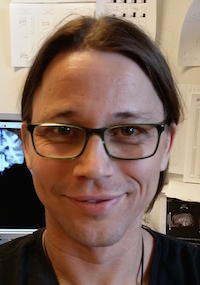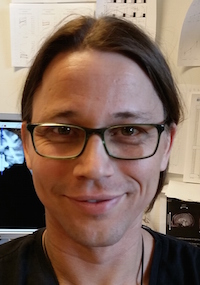Imagine you sprained your wrist. It’s aching, swollen and reddish. You want to move the hand to see if it is ok, but the fear of pain makes you hesitate and it takes extra effort to do it. Even thinking about movement can be unpleasant and you focus on doing things with the healthy hand. After days and weeks, as the trauma heals, the pain passes and eventually you are back on track. In some people, however, these painful symptoms persist, start to spread and gain strength even though the initiating sprain itself has healed.
This is complex regional pain syndrome (CRPS). It begins typically after a small trauma, but then progresses into a devastating chronic painful condition with unpredictably variable daily symptoms. It has serious consequences for patients’ everyday life and is associated with disability and suffering. The affected limb becomes clumsy and weak, and the pain becomes annoying. People with chronic CRPS sometime start keeping their painful limb out of their field-of-vision [Lewis et al., 2007], as if trying to forget the limb and the pain. In addition, because moving the limb is painful, patients avoid movements and in the worst cases, find that a large amount of focus on the part is required to elicit even small movements. Nobody knows exactly how CRPS evolves, but the central nervous system seems to play a role.
In our recently published study ‘Patients with complex regional pain syndrome overestimate applied force in observed hand actions‘ [Hotta et al., 2015], we showed that CRPS patients feel unpleasantness and an increase in pain intensity when they observe others’ motor actions. The painfulness of observing the actions was associated with the painfulness of performing similar actions. Intriguingly, patients estimated that a greater force was applied during the observed actions than the healthy control subjects did. This overestimation of force was associated with unpleasantness and painfulness of observing the actions, but not with the amount of force patients themselves could apply when performing similar movements. The painfulness, unpleasantness and the force overestimation were stronger when patients observed motor actions of the limb corresponding to their painful limb than of the limb corresponding to their healthy limb.
Observation and execution of motor actions are known to activate overlapping brain areas (for a review, see Rizzolatti et al., 2009). We suggest that the association between pain and movement is so strong in CRPS, that plain visual information of actions might be enough to also activate brain areas underpinning pain. In theory, such a strong association might also encourage patients to avoid visual control over their own actions, making already diminished motor skills even worse.
Healthy people overestimate the force they apply if the performed movement is painful [Weerakkody et al., 2003]. We speculate that in CRPS the varying pain levels might disturb patients’ estimate of applied force. This, together with the increased sensation of effort for movements, might explain our findings of patients misestimating the force others apply.
One of the main targets in treatment of CRPS is to ease the pain so that patients may start practicing their lost motor skills. Unfortunately pain in CRPS is highly resistant to drugs. One popular treatment protocol is the so called “graded motor imagery” [Moseley, 2004]. In this therapy patients are encouraged using sequential steps to proceed from hand-laterality-recognition practice to imagined movements and further, to mirror therapy, and actual movements. In CRPS, even the imagined movements can cause pain [Moseley et al., 2008] and action observation has been suggested as an even more gentle exposure to motor actions [Moseley et al., 2009]. Based on our results it seems that in CRPS action-observation truly tickles the affected motor pathways in the brain and it could thus be of use in therapy.
Complex regional pain syndrome is not just a disease of a limb but it affects the lives of patients in numerous ways. Our study gives insight into how one aspect of CRPS modulates the patient’s world view, and suggests that pain is in the eye of the beholder.
About Jaakko Hotta
 Jaakko is a licensed physician graduated in 2004 from Faculty of Medicine in University of Helsinki. At the moment he is working partly in the Department of Neurology at Helsinki University Hospital, trying to get his degree in neurology done by the end of the year, and at the same time doing research in the Department of Neuroscience and Biomedical Engineering at Aalto University, trying to complete his doctoral thesis on CRPS. His special interests are in the couplings of brain and CRPS. His research is done in close collaboration with the Pain Clinic at Helsinki University Hospital.
Jaakko is a licensed physician graduated in 2004 from Faculty of Medicine in University of Helsinki. At the moment he is working partly in the Department of Neurology at Helsinki University Hospital, trying to get his degree in neurology done by the end of the year, and at the same time doing research in the Department of Neuroscience and Biomedical Engineering at Aalto University, trying to complete his doctoral thesis on CRPS. His special interests are in the couplings of brain and CRPS. His research is done in close collaboration with the Pain Clinic at Helsinki University Hospital.
References
Hotta J, Harno H, Nummenmaa L, Kalso E, Hari R, Forss N (2015): Patients with complex regional pain syndrome overestimate applied force in observed hand actions. Eur J Pain. Epub ahead of print.
Lewis JS, Kersten P, McCabe CS, McPherson KM, Blake DR (2007): Body perception disturbance: a contribution to pain in complex regional pain syndrome (CRPS). Pain 133:111–9.
Moseley GL (2004): Graded motor imagery is effective for long-standing complex regional pain syndrome: a randomised controlled trial. Pain 108:192–8.
Moseley GL, Zalucki N, Birklein F, Marinus J, van Hilten JJ, Luomajoki H (2008): Thinking about movement hurts: the effect of motor imagery on pain and swelling in people with chronic arm pain. Arthritis Rheum 59:623–31.
Moseley GL, Birklein F, van Hilten JJ, Marinus J (2009): Reply. Arthritis Care Res (Hoboken) 61:140–141.
Rizzolatti G, Fabbri-Destro M, Cattaneo L (2009): Mirror neurons and their clinical relevance. Nat Clin Pract Neurol 5:24–34.
Weerakkody NS, Percival P, Canny BJ, Morgan DL, Proske U (2003): Force matching at the elbow joint is disturbed by muscle soreness. Somatosens Mot Res 20:27–32.



